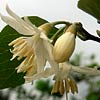Officinal Styrax is a short tree (up to 6 meters). Its leaves are white and covered with hairs (hirsute) on their lower side. The number of petals of tree is variable. The number of petals is mostly 5, but often also 6 (which is considered exceptional among dicotyledonous plants), and sometimes even 7 or 8. The leaves are alternate. The leaf is simple, soft, round to ovate. It grows in several different habitats and plant associations.
The tree is winter-deciduous. In the autumn its leaves turn yellow and in spring the sprouting is light green. The tree blooms in late spring, from April to June. The calyx is green, with fused petals (Sympetalae), 5 teeth at its tip and it persists in the fruit. The corolla is pure white, with 5-8 petals, which are fused only at their bases. The size of the flower is 20 mm. The ovary is superior, with one style. There are 8-16 stamens, double the number of the petals. They are white-yellowish and are fused at their bases. The flowers hang downwards. The flower resembles citrus blossoms, and even disseminates a pleasant fragrance that is reminiscent of the scent of citruses, even though they do not have the same origin. The entire tree is laden with flowers, and the flower abounds with nectar. It is therefore known as an important honey plant.
The fruit ripens in September-November. It is green to yellow, covered with hairs (hirsute), has the shape of ball with a diameter of 15 mm with a long and soft apex. The fruit has a single brown and shiny stone with the seed, which contains a toxin. It is enveloped by a green pulp which is very bitter to humans but tasty to sheep. In the literature it is written that the pulp of the fruit is toxic, but it appears that only the seed is toxic, since sheep eat it with great passion and are not harmed by it. They excrete the toxic seed in its entirety. The seed is the size of sheep droppings (and is even similar in color), and the seeds are excreted individually as droppings. In the past the toxic seed was ground and mixed in flour in order to prepare bait for fish. The fish would eat the bait and die, float on the water, and the “fishermen” would collect them, remove their intestines and eat them. It was also used for making mice poison. The stone is hard, durable, has a nice shape and color, and is therefore a favorite for people who string beads. Piles of stones are heaped at the foot of the tree after the pulp has rotten.
The tree is planted in gardens and is used in gardens to add a light green color in a landscape of dark green trees.
Styrax officinalis grows in Israel in all regions from Judea northward. It has sometimes remained in large concentrations in forests that underwent felling, such as Odem Forest in the Golan Heights. This is explained by the fact that it is sacred to the Muslims because of the tradition that the staff of Moses (who is revered by the Muslims as well) was made of this tree. Others claim that the trees have remained because they are not eaten by sheep (except for the fruits), and even man has not found use for them, not even for heating, because their smoke is considered to be toxic. The branches were sometimes used for sweeping dung in the sty.
Styrax officinalis grows well in different environments: in sediment rocks, basalt, tuff, conglomerate and kurkar (aeolianite); in limestone from the Middle Eocene in the Upper Galilee and from the Eocene in the Lower Galilee. It is integrated within different plant associations: together with Quercus ithaburensis, Pistacia atlantica and Cercis siliquastrum in the Hula Valley, in the Kadesh Valley and in the Alonim-Shefaram hills; together with Quercus calliprinos and Quercus boissieri in the basalt soil of Odem Forest in the Golan Heights; together with different Rosaceae and Quercus look on Mount Hermon up to an elevation of 1600 meters.
The name officinal was given to the Styrax by the Swedish researcher Linnaeus, who erroneously thought that incense is extracted from it.
Nonetheless, it has been claimed that a solid resin is extracted from different species of Styrax, which has a vanilla scent and contains a material called benzoin, and a partially liquid resin with a hyacinth scent, which are used for the manufacture of medicines and cosmetics.
Its global distribution ranges over the Eastern Mediterranean countries, from Italy through Greece, Turkey, Syria and Israel.
The Stryracaceae family includes 6 genera and 115 species.
Written by Mike Livne






